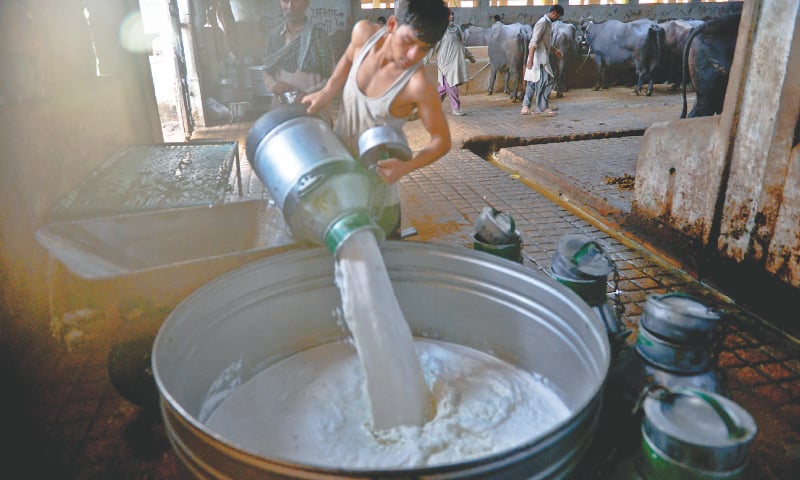KARACHI: Driving up to Landhi you reach an area on the rather bumpy Mehran Highway where pick-ups and lorries number more than the other vehicles. Those coming in are empty but the ones driving out are loaded with dozens of silver milk canisters. Well, of course, why wouldn’t they be? After all, this is Bhains Colony, the place the entire city gets its milk from.
You can pick up some moos coming from various directions. But there are hardly any cattle roaming about freely here or there. That’s because they are all doing the work inside the dairy farms on either side of the road. The animals there eat and drink all day to stay healthy and be able to produce lots and lots of good quality milk.
“We milk our buffaloes twice in 24 hours — at 4am and 4pm,” says Imtiaz Ahmed, one of the staff supervisors at Shaukat Mukhtar Farms. There are some 450 buffaloes at the farm and almost all are lined up to enjoy their feed as the men milk them manually by hand.
“Eating keeps them busy. So as they munch on their feed they stay in one place for us to be able to milk them,” he says. To ensure that the dairy workers don’t get kicked in the face by the buffaloes, they also lightly tie up their hind legs while milking them.
Asked why they don’t have pumps for milking, he explains that there are pumps too at several dairy farms in Bhains Colony, but at their farms they prefer to milk by hand. “Usually, we use pumps to milk cows, not buffaloes. Cows give more milk, too. Pumps are good for milking in quantity. But cows’ milk is thin while buffalo milk is thicker and richer,” he explains.

The feed the animals eat has been specially designed and is highly nutritious to help them produce more milk. “It contains wheat, porridge, lentils, mustard, spinach greens, Malaysian palm oil, corn, ghee, etc,” he says.
The dairy workers with stainless steel buckets and metal canisters bring over the milk they collect to pour into big metal tubs placed at various points. “Fresh milk is warm. Keeping it in big tubs helps it to cool slightly before sending it off to the market,” shares Aslam Malik, another staff member at the farm. And he adds that the milk better reach the milk shops in a couple of hours otherwise it can go bad.
“The shops have chillers and refrigerators to store it properly but we here only concentrate on the production part of it,” he says, adding that the milk is absolutely pure at this point. “Forty litres of milk carries about 4kg of cream,” he says gesturing to the layer of cream floating on top of the milk in the tubs. “But once this milk leaves this place, it will be tampered with and diluted according to the conscience of the people who are into this kind of dishonesty,” he says.

The milk is sold for Rs70 per litre at the dairy farms and in the shops it is sold for Rs80 or 85 a litre.
“The price was only increased earlier this month from the previous rate of Rs66 per litre,” he says.
The dairy farmers say that everyone should have fresh milk instead of the packaged variety. “What you get in the name of milk in a box is something devoid of the healthy fats, cream and nutrition. It is processed milk where they have taken away the fat for making side products such as cheese, butter, ghee, yogurt, lassi, etc,” says Malik.
The dairy farmers buy new cattle every month to replace the ones that have finished their milking cycle and are considered spent. These could then be sent off to the slaughterhouse or to a farm where they can take a short break before insemination and parturition before lactating again.
The best cattle, the farmers say, are from Badin in Sindh and from the Ravi area in Punjab. These may cost between Rs160,000 to Rs200,000. They also have foreign cows and buffaloes such as the black and white ones from Australia, which are known for producing more milk than the local varieties, but these are very expensive and delicate so they require more care.
Published in Dawn February 19th, 2017
















































Dear visitor, the comments section is undergoing an overhaul and will return soon.